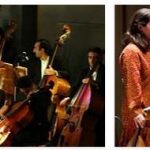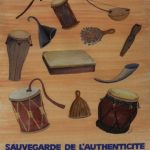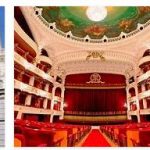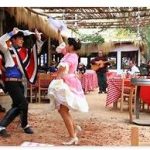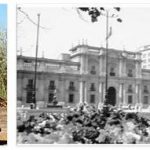CULTURE: ART
In the valleys of northern Chile, a necropolis and a fortress (impregnable on three sides) have been discovered which are linked to the “El Molle” culture, characterized by a type of thick ceramic and brightly decorated in a geometric style. In the oases of the Atacama Desert, the Atacameños built urban centers of two characteristic types: the pucara (fortress in a hilly area, surrounded by walls called pircas) and the pueblo viejo (inhabited without defensive walls), which however have no value. artistic; clay art is sometimes affected by Andean influences. The third Chilean culture, that of the Diaghiti, is known above all for its urns and for an original type of shoe vase, called jarro zapato, but also interesting are the copper and bronze jewels which later, due to Inca influence, were melted in gold and silver. In the recent history of Chile, the visual arts have assumed a very particular function: since 1970 an “art of intervention and agitation” has developed, which has accompanied the renewal of the government of Unidad Popular and has become courageous opposition to the dictatorship after its fall. It was attended by artists, such as the painter and graphic artist José Balmes, young people and students, organized in “brigades” active throughout the country; the favorite forms were the mural painting (murals) and the poster. Among the initiators of the surrealist and expressionist movements, of European influence, in Chilean art, emerges above all Roberto Matta Echaurren (1911-2002), to whom, during the twentieth century. Internationally recognized personalities followed: Pedro Reszka (1872-1960), Camilo Mori (1896-1973), the sculptors Samuel Román (1907-1990) and Marta Colvin (1917-1995), Mario Carreño (1913-1999). Among the most appreciated contemporaries we remember Gonzalo Diaz (b. 1947), who ranges from photography to installations, such as Ciro Beltran (b. 1965), Rodrigo Cabezas and many others belonging to the so-called “generation of the 90”.
CULTURE: MUSIC
The cultured musical life of Chile did not present reasons of particular interest during the period of the Spanish domination. The first relevant figure among the composers was M. Robles (1780-1837). In the sec. XIX emerged the clarinetist, band director and composer J. Zapiola (1804-1885), who founded a symphony orchestra in Santiago in 1842, and F. Guzmán (1837-1885), linked to European romanticism. The formation of a national school open to the use of elements taken from folklore was the merit of the composers born between 1880 and 1890, of which it is worth mentioning H. Allende, A. Allende and C. Isamitt. Chilean folk music is linked to components of Spanish origin, which have not mixed indigenous elements. Dell ‘ original indigenous tradition few elements survive referring to the ethnic groups of the Araucani and other indie populations: these are propitiatory dances and primitive music linked to religious ceremonies. In the early twentieth century there was a great development of musical life in Chile, a country located in South America according to localcollegeexplorer. In particular in the twenties where Enrique Soro (1884-1954) and Alfonso Leng (1894-1974), author of the symphonic poem, established themselves La muerte de Alsino with clear references to Richard Strauss. But it is with Domingo Santa Cruz (1899-1987) that Chilean music underwent a profound transformation. Santa Cruz used polytonal harmonies in his compositions, often dissonant, albeit within baroque and classical structures. His stylistic experiment influenced the next generation of musicians, including Juan Orrego-Salas (b.1919), well known internationally. A great deal of international attention, however, was also paid to the singer-songwriters and folkloric musical groups of the seventies who, forced into exile by the military dictatorship, widely spread the Chilean popular and political protest song in Europe. Among the best known: the Inti-Illimani, the Quilapayùn, the Cantores de Quilla Huasi and the Canto General.
CULTURE: THEATER
There were theatrical performances since 1646, but throughout the colonial period they took place above all on the occasion of religious festivals, in Jesuit schools or at court. The first permanent theater was built in Santiago de Chile in 1802; for about a century and a half. the various ways and schools of European theater were reflected here, with not negligible contributions from local playwrights. The actors-directors dominated and the selection criteria were above all commercial. The situation began to change around 1936, following the emigration of the great Spanish actress M. Xirgu to Chile, who introduced Lorca’s works and a more modern idea of the theater. In its wake, and thanks also to the electoral victory of Aguirre, two important scenic renewal initiatives were born in the 1940s, both originated from the student world: the Teatro Experimental de la Universidad de Chile (1941), then the Instituto del Teatro de la Universidad de Chile, which presented above all classics and works of good quality from the European and American repertoire, and the Teatro de Ensayo de la Universidad Católica (1943), which focused more on national authors. The Chilean theater was characterized, up to the sixties, by representations concerning the history and folklore of the country, in particular with the works of F. Debesa (1921-2006), J. Rojas (b.1937), LA Heiremans (1928 -1964). Subsequently, contents of social denunciation prevailed with the texts of I. Aguirre (n.1919), S. Vodanovic (1927-2001), E. Wolff (n. 1926), for the most part inspired by Brecht.

